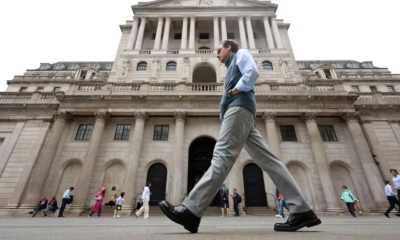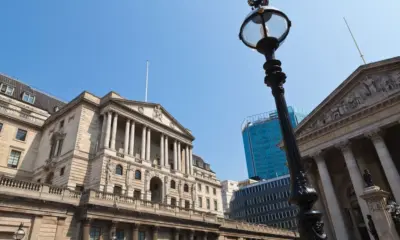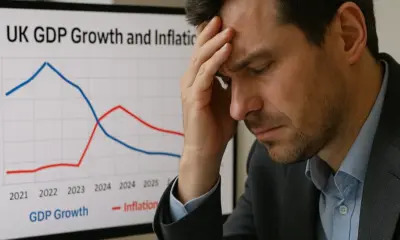Business
Bank of England Maintains Rates Inflation Falls to 2.7 Percent

The Bank of England has decided to keep its benchmark interest rate unchanged as inflation continues to ease, dropping to 2.7 percent in the latest figures from the Office for National Statistics. The decision, which marks the fifth consecutive meeting without a rate increase, reflects growing confidence that inflationary pressures are gradually receding after a challenging period of economic turbulence. However, policymakers have cautioned that further vigilance is necessary to ensure stability in prices and wages before considering any reduction in borrowing costs.
A Cautious Pause in Monetary Policy
The Monetary Policy Committee voted by a narrow majority to maintain the base rate, highlighting the ongoing debate within the Bank about how best to balance economic recovery with price control. While inflation is moving closer to the central bank’s target of two percent, officials remain concerned that premature cuts could reignite demand-driven price increases. The Bank’s statement emphasized that the decision to hold rates steady allows for continued monitoring of wage growth, energy costs, and consumer spending trends.
Governor Andrew Bailey reaffirmed the Bank’s commitment to maintaining price stability, noting that although progress has been made, the fight against inflation is not yet complete. The Bank expects inflation to return to target by mid-2026, supported by improved energy prices and more stable supply chains. At the same time, officials acknowledged that higher borrowing costs have placed pressure on households and small businesses, particularly those with variable-rate mortgages and loans.
The policy pause also reflects the global economic environment. Central banks across Europe and North America are similarly holding rates steady as they assess the cumulative impact of previous hikes. In the United States and the eurozone, inflation has also moderated, signaling a potential turning point in the global monetary tightening cycle. However, the Bank of England remains wary of diverging too quickly from its peers, as doing so could risk volatility in currency markets and capital flows.
Financial markets responded calmly to the announcement. The pound remained stable against major currencies, while gilt yields showed minimal movement, indicating that investors had largely anticipated the decision. Analysts interpreted the Bank’s tone as cautiously optimistic but noted that future policy shifts will depend heavily on the pace of wage growth and energy price trends in the coming months.
Inflation Trends and Economic Outlook
The decline in inflation to 2.7 percent represents a significant improvement from last year’s highs, when consumer prices had risen at the fastest rate in more than four decades. Falling energy costs, improved global supply chains, and easing food prices have all contributed to the decline. The government’s recent energy price guarantee and measures to support domestic production have also helped stabilize household budgets.
Despite these improvements, not all sectors are feeling relief. Service inflation remains elevated, particularly in hospitality, transport, and healthcare. Wage growth, though moderating, is still running above inflation, suggesting that underlying price pressures may persist longer than expected. This combination of improving headline figures but lingering core inflation has created a complex environment for policymakers trying to judge the right moment to ease monetary policy.
The broader economic picture remains mixed. The UK economy has shown modest growth in recent quarters, avoiding a technical recession, but productivity and investment remain subdued. Business confidence has improved slightly, supported by easing inflation and signs of stronger export demand, particularly in financial services and manufacturing. However, consumer spending continues to lag, reflecting the cumulative strain of high borrowing costs and stagnant real wages.
Government officials have welcomed the latest inflation figures as evidence that their fiscal policies are working. Chancellor Jeremy Hunt described the progress as a step toward long-term stability but urged continued discipline in both public spending and monetary management. Economists agree that while inflation is on a sustainable downward path, the recovery remains fragile and dependent on external factors such as energy markets and geopolitical tensions.
The Path Ahead for Interest Rates
Looking forward, financial markets are increasingly betting that the Bank of England could begin cutting rates by the end of 2025 if inflation continues to fall and economic growth remains subdued. However, central bank officials have avoided giving firm guidance, preferring to maintain flexibility. Governor Bailey emphasized that any future decisions will be data-driven, guided by evidence of sustained progress in both inflation and wage moderation.
Some economists argue that holding rates higher for too long risks stifling growth and prolonging financial strain for households. Mortgage lenders have already begun reducing fixed-rate offers in anticipation of lower rates next year, suggesting that the market expects gradual easing. However, others caution that reducing rates too soon could reverse the gains made in controlling prices, particularly if global oil prices rise or supply disruptions reemerge.
The next few months will be critical for determining whether inflation continues its downward trend. The Bank will closely monitor holiday spending, wage settlements, and business investment data to assess how entrenched inflationary expectations remain. A stronger-than-expected rebound in consumer demand could complicate the Bank’s timeline for easing policy, while continued moderation would support a more accommodative stance.
Conclusion
The Bank of England’s decision to maintain interest rates underscores a cautious optimism about the state of the British economy. With inflation easing to 2.7 percent and economic indicators showing gradual improvement, policymakers are signaling that the worst of the inflation crisis may be over. Yet the path ahead remains uncertain, as global volatility and domestic wage pressures continue to pose challenges.
For households and businesses, stability in interest rates offers a measure of relief after years of uncertainty. The coming year will determine whether this period of steady policy marks the beginning of a sustainable recovery or a temporary pause before further adjustments. Either way, the Bank’s approach reflects a delicate balancing act between sustaining growth, protecting purchasing power, and maintaining credibility as the guardian of price stability.




















